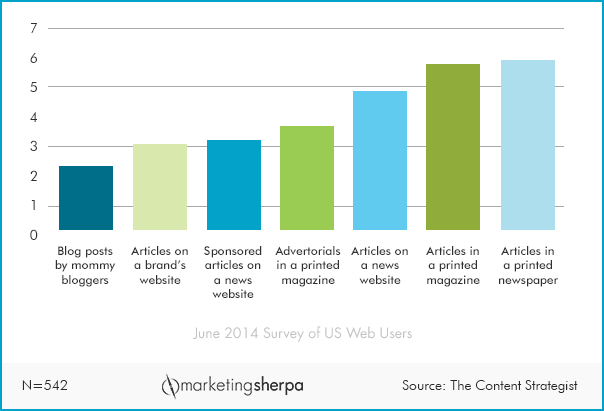by
Daniel Burstein, Director of Editorial Content
In a June 2014 survey by The Content Strategist, U.S. Web users were asked:
Q. What do you think is generally higher quality?
Click here to see a printable version of this chart
Print reigns supreme
Much (pixelated and real) ink has been shed about the death of print, but don’t fill out the obituary just yet.
Articles in a printed newspaper and articles in a printed magazine were considered by far the highest-quality content.
"This particular chart is interesting; it shows that people have a clear bias toward print still — which I suppose might be under the assumption that if you go through the trouble to print something, it's hopefully pretty good," said Joe Lazauskas, Editor-in-Chief, Contently (which publishes The Content Strategist).
That trust in printed content is extremely valuable. Here’s how you can leverage the value:
Use print to build credibility for your online content marketing
If you’re buying traditional print advertisements in magazines or newspapers, you don’t only have to promote products, especially if you have a complex sale. Just try to achieve a micro-yes and promote your online content.
For example, if you sell a multi-million dollar software package, instead of just a generic brand ad, promote a specific white paper — your digital content will stick out more and be more credible thanks to the power of print.
Publish your content in someone else’s publication
Aside from using print ads to promote content and move a prospect along the funnel, you can turn your ad into content.
This isn’t a new tactic, of course. However, the digital twist is, for example, printing one of your blog posts as an editorial as proof of the high-quality content your blog offers with a CTA to encourage readers to get more, similarly high-quality content, on that blog.
While advertorials in a print magazine were not considered higher quality than the actual editorial in print or online, they were considered higher quality than sponsored or brand content that is published online.
Produce your own print publication
Publishing the same content in print versus online will likely increase the perceived quality of that content. Red Bull, John Deere, LifeTime Fitness and Walmart publish print magazines, and Airbnb just announced its own print pub as well.
"Personally, we at Contently have had wild success with our quarterly print magazine (Contently Quarterly)," Lazauskas said. "It's a great asset for our marketing and sales team and a significant revenue-driver. Print may seem outdated, but it's becoming increasingly special as print publications become rarer."
Digital content has its place, but needs some work
Producing digital content is so much easier and cheaper than producing print.
Now, mind you, I didn’t say producing good digital content is easy. That’s the problem. Because of this ease, customers are exposed to an endless amount of digital content, much of it produced for the wrong reason (attracting search engine spiders with keywords or pushing products instead of actually helping customers).
"It's also clear here that brands still have some work to do when it comes to improving the reputation of the content they post on their owned sites — telling stories that provide value to your customers, instead of just posting self-promotional copy — is a great place to start," Lazauskas advised.
On the upside, though, articles on a brand’s website were viewed as higher quality than blog posts by mommy bloggers and nearly as high-quality as sponsored articles on a news website.
This shows that customers may overlook the conflicts of interest inherent in brand’s self-published content since they have the resources and knowledge to potentially produce helpful information — as opposed to mommy bloggers, where one would expect less conflicts of interest but also less resources and subject matter expertise.
Companies need to focus on that subject matter expertise and use it to help customers overcome problems and meet their goals, regardless of whether they buy your product or not.
That, at the end of the day, is the key to producing high-quality content — help customers meet their goals, not yours.
Related Resources
Subscribe to Chart of the Week — Learn from your peers
Study: Most Readers Have Felt Deceived by Sponsored ContentRed Bull Media House’s Advice for Successful Content MarketingCustomer Value: The 4 essential levels of value propositionsConversion Rate Optimization: Building to the Ultimate YesHow to Keep Subscribers Engaged with Your Brand via Personalized Content — to be presented by Diana Primeau, Director of Member Services, CNET at
Email Summit 2015 in Las Vegas










